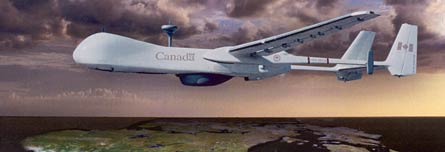The Canadian defence force wants to arm its planned medium-altitude long-endurance (MALE) UAV systems.
A final requirements statement recommending a weapons capability is due to be signed off within the defence headquarters late this month ahead of formal applications for government funding approvals.
If it is granted, a competition launch for up to nine MALE systems is planned for almost immediate release with a contract signature by mid 2007, says project director LtCol Wade Williams, Royal Canadian Air Force.
The joint UAV surveillance targeting acquisition system (JUSTAS) project is forecast to cost C$500 million ($446 million) with an initial operational capability targeted for February 2009.
Speaking 9 November at the Unmanned Vehicle Systems Canada 2006 conference in Montebello, Quebec, Williams said that weaponisation had been deemed a mandatory requirement for the project: “We are looking to provide a weapons capability for the folks in theatre”.
No details on the proposed weapons mix were discussed.

The new UAVs would carry a mixture of electro-optic, infra-red and synthetic aperture radar payloads with persistence of capability being a key programme aim. “The longer this thing can stay up the better. The lessons learned that we are learning today in Afghanistan are critical,” says Williams.
The system is required to be globally deployable he said, in all weather conditions: “Basically anywhere in the world that the Canadian Forces should be ready to go”.
Williams said that while Canadian joint capability requirements board approvals are imminent, the overall JUSTAS project “has not been Governmentally approved yet. This is us in the Department at the staff level trying to work this programme through as quick as we can. We all know the government is very limited in resources. Is this going to be a government-approved policy? We will all find out as the policy people and the Prime Minister and the minister decide really where Canada’s treasury is going to be spent.
“But this is very much our aim and this is what we are focusing towards but by no means guaranteed..
He said that the project is “moving at a great rate of knots through the Department of National Defence right now” to try and achieve the service entry target: “We are now in the statement of requirements and working the problematics through the system. We are looking to go on contract for sometime in the Summer of 2007…To make the IOC by February 2009 there is no other way around it”.
The JUSTAS project is intended to acquire MALE and HALE classes of aircraft. The project was substantially restructured in August this year to separate the two requirements into a two phase acquisition effort. The current phase one is intended to provide a near term Canadian Forces overland surveillance capability that will support both domestic and expeditionary operations based on nine UAVs.
Phase two will introduce a maritime surveillance capability comprising up to six HALE aircraft and an additional three MALEs by 2025. The phase two capability will also incorporate a northern surveillance role in the Canadian Artic territories.
Williams described “the purely maritime capable UAV” as being “still several years out. Many of our allies that we deal with quite a bit, the Americans and the Australians, are looking at 2010-2015 and I honestly don’t believe that Canada is looking at being first in that crowd. We plan on leveraging off our friends.”
The two classes of UAV system would share payloads between them Williams said. “The idea is that we are not going to be acquiring a vehicle that is completely locked down – we need some flexibility to try to move sensors and do other things.”
Restructuring of the project has also seen the separation of the UAV system purchase from the development of the Canadian Forces joint intelligence, surveillance and reconnaissance processing architecture as a result of the August project restructuring. Williams described that decision has having been a “significant achievement in understanding our [project] aim”. Instead, that “ISR backbone” will be developed as part of the separate but closely related joint service intelligence command and control system project.
The nominal project spend pattern would see initial outlays of C$5 million in the current financial year; C$80 million 2007-2008; C$100 million in 2008-2009; C$120 million in each of 2009-2010 and 2010-2011; and C$75 million in 2011-2012.
The two primary contenders for the project are General Atomics Aeronautical Systems Inc, teamed with General Dynamics Land Systems Canada and offering the MQ-9 Predator B; and Montreal-based MacDonald, Dettwiler and Associates (MDA), teamed with Israel Aircraft Industries, CAE, and Pratt and Whitney Canada to offer a modified IAI Eagle.
The MDA team is also proposing the IAI I-View 50 small tactical, Bird Eye 400 mini- and Mosquito micro-UAVs for expected Canadian Army tactical UAV competitions, with all four UAV types to operate within a common ground architecture as a fully integrated family of systems.
Williams told the conference that Canada was seeking to achieve certification for the new UAVs. He said: “We are not looking to buy something that is truly a test vehicle; we want something that is somewhat proven or recognised by another nation.”
Source: FlightGlobal.com























